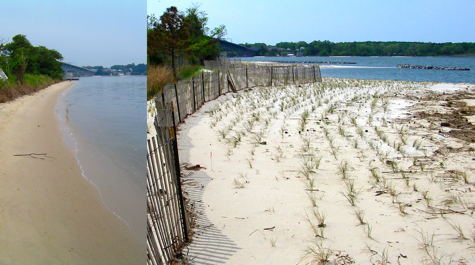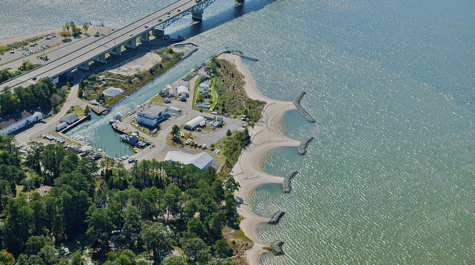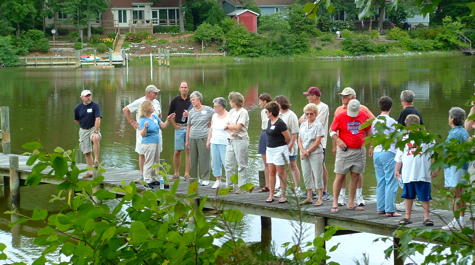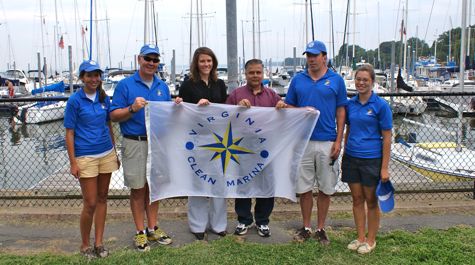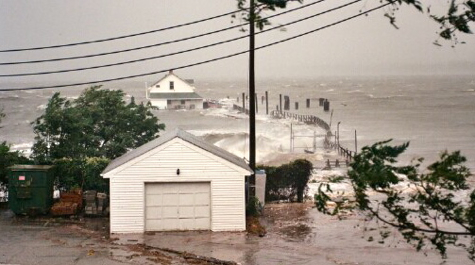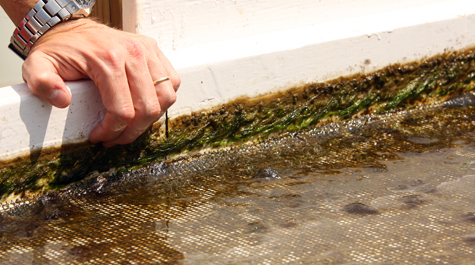VIMS strives to make every day Earth Day
In addition to its ongoing work to protect and restore Chesapeake Bay and its marine life, the Virginia Institute of Marine Science has redoubled its efforts during the last few years to promote the types of “green” infrastructure and activities that are celebrated each year on Earth Day.
These endeavors—which represent a true collaboration among VIMS’ faculty, staff, and students—focus on coastal resiliency, alternative energy, stormwater management, sustainable seafood, and campus-wide energy efficiency.
A resilient & living shoreline
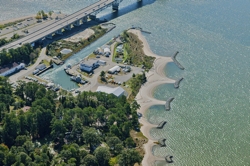 As sea level continues to rise and hurricanes and nor’easters
continue to visit the mid-Atlantic coast, stress on local shorelines continues
to increase. In the last decade alone, three storms—Isabel, Ernesto, and the
Veteran’s Day storm of 2010—have wreaked havoc on VIMS’ York River shoreline
and its piers.
As sea level continues to rise and hurricanes and nor’easters
continue to visit the mid-Atlantic coast, stress on local shorelines continues
to increase. In the last decade alone, three storms—Isabel, Ernesto, and the
Veteran’s Day storm of 2010—have wreaked havoc on VIMS’ York River shoreline
and its piers.
To address this growing threat, VIMS last year invested in an erosion-control project in which eight stone breakwaters were constructed along both shores of VIMS’ Gloucester Point campus. The project—designed by Vanasse Hangen Brustlin of Williamsburg and built by Coastal Design and Construction of Gloucester—was based on work by Scott Hardaway of the Shoreline Studies Program at VIMS.
The breakwaters incorporate elements of the “living shoreline” movement championed by the Center for Coastal Resources Management at VIMS. Living shorelines use strategic placement of stone, plants, and sand to reduce erosion, enhance wetland habitat, reduce stormwater runoff, and provide important ecosystem services. The VIMS project also provides a working example of a living shoreline for use in education and outreach.
Hardaway and his staff provided technical advice concerning the size, shape, and placement of the VIMS breakwaters. Their advice was based on field measurements and computer models to identify the particular conditions under which the breakwaters will operate. Hardaway’s team characterized prevailing winds and waves, predicted water levels for 50- and 100-year storms, and mapped seafloor and shoreline profiles.
Biofuels & Wind Energy
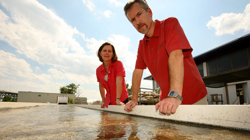
A VIMS team led by professors Emmett Duffy and Elizabeth Canuel continues to study the feasibility of converting oil from wild algae into a fuel that can help power our cars.
The focus of the team’s research—part of the collaborative, multi-institutional Chesapeake Algae Project (ChAP)—is to measure the oil content of various wild algal strains, and to determine how algal growth rates, oil production, and pollutant scrubbing vary with temperature, salinity, light levels, and other environmental factors.
These experiments are all part of an overall effort to better understand how the ChAP concept might scale up to the levels needed to make an appreciable dent in our nation’s 20-million-barrel per day oil consumption.
VIMS, a member of the Virginia Coastal Energy Research Consortium, was also recently chosen to provide research and support services for a test and demonstration wind turbine planned for the Cape Charles area of lower Chesapeake Bay. Development of wind energy in the Commonwealth is a major goal of both Governor Bob McDonnell and the General Assembly, which last year created the Virginia Offshore Wind Development Authority.
Stormwater management
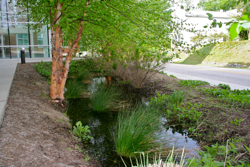 VIMS continues to practice “best management practices” (BMPs)
in regards to stormwater discharge on its 40-acre campus, and to educate local
citizens and agencies in the proper application of BMPs to their own properties
and jurisdictions. Unregulated runoff of stormwater, and its associated loads
of nitrogen and other pollutants, is a major contributor to poor water quality
in Chesapeake Bay.
VIMS continues to practice “best management practices” (BMPs)
in regards to stormwater discharge on its 40-acre campus, and to educate local
citizens and agencies in the proper application of BMPs to their own properties
and jurisdictions. Unregulated runoff of stormwater, and its associated loads
of nitrogen and other pollutants, is a major contributor to poor water quality
in Chesapeake Bay.
Ron Herzick of VIMS' Facilities Management Department says that VIMS not only complies with all control measures outlined in its stormwater management permit, but has also applied several innovative techniques that take advantage of its unique landscape and geology.
Carl Hershner, head of the Center for Coastal Resources Management (CCRM) at VIMS, notes that one such technique is use of the “moat” surrounding the Civil War fortifications on the VIMS campus as a ready-made retention pond. The sandy soils that underlie the moat and most of the VIMS campus allow for rapid percolation of stormwater and filtration of any contaminants that it might carry. That contaminant load is likely to be small due to ongoing training of VIMS landscape crew, and their use of native plants and minimal application of lawn and garden fertilizer.
CCRM also created and operates the VIMS Teaching Marsh, a demonstration tidal wetland that filters runoff from the Coleman Bridge before it can enter the York River.
In addition to its success at minimizing stormwater runoff, VIMS has also received recognition for its exemplary performance in managing campus wastewater. In 2010, VIMS received a Diamond Award from the Hampton Roads Sanitation District for 10 consecutive years of perfect compliance with its wastewater permit. VIMS also received an Industrial Waste and Pretreatment Environmental Excellence award in the Platinum Category from the Virginia Water Environment Association.
Sustainable seafood
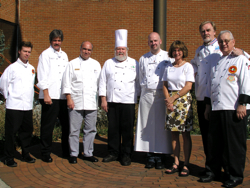 Vicki Clark, Marine and Seafood Education Specialist with the Marine Advisory Services program at VIMS, continues
to organize and host the Chefs' Seafood Symposium, an annual educational
program for culinary professionals, culinary students, and representatives from
the seafood industry and related businesses. During the full-day event, scientists
and chefs provide the latest information on seafood science, fisheries issues,
and cooking techniques. Participants leave with information, resources, and
recipes to help them make more informed seafood choices as well as tastier
dishes!
Vicki Clark, Marine and Seafood Education Specialist with the Marine Advisory Services program at VIMS, continues
to organize and host the Chefs' Seafood Symposium, an annual educational
program for culinary professionals, culinary students, and representatives from
the seafood industry and related businesses. During the full-day event, scientists
and chefs provide the latest information on seafood science, fisheries issues,
and cooking techniques. Participants leave with information, resources, and
recipes to help them make more informed seafood choices as well as tastier
dishes!
In celebration of Earth Day, Clark agreed to share several seafood recipes using species that have been the focus of VIMS research, and that are harvested sustainably according to the National Marine Fisheries Service. “All these recipes currently have a “good alternative” rating by the Seafood Watch program,” says Clark.
Using energy more efficiently
VIMS, in partnership with Virginia’s Division of Mines, Minerals, and Energy, has entered an energy performance contract with Siemens that pays for upgrades to lighting, plumbing, and heating and air-conditioning systems through subsequent savings on utility bills. The payback period is estimated to be 15 years or less.
The process began with energy audits of three buildings—Watermen's Hall, Chesapeake Bay Hall, and Nunnally Hall—that revealed several areas where equipment upgrades would lead to substantial energy savings. These included replacing old lighting fixtures and bulbs with new, more energy efficient models; and installation of motion-sensor lighting in low-traffic areas.
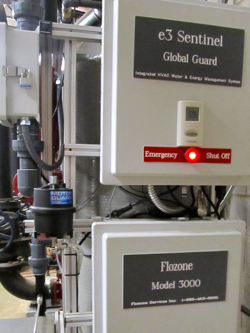
Installation of new, high-tech Flozone® units on the buildings’ cooling towers also led to significant savings in money, energy, and water. The water used in air conditioning systems is typically treated with chemicals to reduce bacterial growth that can lead to health problems and impede flowage and energy transfer. Flozone® instead treats the cooling water with ozone, a more efficient and environmentally friendly technology. It also applies radio waves to increase the cooling water's ability to carry solids in solution—thus lowering water consumption by decreasing the need for back-flushing.
Richard White, VIMS Facilities Director, says the energy and cost savings from these projects is already apparent.


